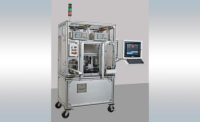Experience is key to leak testing

Flow and leak testing are required for any medical device that brings a substance to or from the body. Flow testing ensures that there are no blockages and the substance being delivered can make it through. Leak testing determines if a product leaks, and in some cases, where it leaks and by how much.
In most cases, every product coming off the assembly line must be tested. However, this means manufacturers must balance the time it takes to test with the increased risk from lower “passing” standards. While leak and flow testing are intended to keep consumers safe, they can be an unnecessarily complicated step for medical device manufacturers.
Working with the manufacturers of leak testers can help. Don Parr, vice president of sales at Zaxis, suggests that to eliminate headaches during production, leak testing should be a priority from the product design phase.
“If [manufacturers] understand how a leak test works, it will help them to design better products and achieve more realistic throughput,” he says.
Jacques Hoffmann, president of InterTech Development, agrees that understanding how testing works will help the process, and he recommends working with leak test manufacturers to create a customized testing system.
“Testing is more than the tester. You want to work with someone who understands the customer application, the instrument and the tooling,” says Hoffmann.
Experience can eliminate many problems that can occur when testing medical devices. Medical device engineers are well-advised to consult with a leak testing supplier during the design phase of the product. Parr says a common issue is that products are designed in a way that makes them untestable. By designing products with leak testing in mind, manufacturers can save themselves time and hassle. For example, medical devices frequently have small orifices and multiple transfer paths to test. This can make sealing and clamping more difficult than other leak testing applications.
Hoffman states that experience can also allow for better testing results. Knowing when to use a tracer gas vs. standard filtered air, or being able to recommend the proper tooling for product testing comes from years of experience. For example, implantable devices, such as pacemakers and infusion pumps, are typically tested with helium, while dry air is usually used to test invasive devices, such as catheters and surgical instruments.
Leak test manufacturers also understand how to test without using water or liquids that can contaminate products. Understanding the correlations between liquid and air pressure is crucial.
Suppliers can also provide guidance on how to integrate leak and flow testers into high-volume automated assembly lines. Here again, understanding how testing works is important. Many engineers underestimate the time needed for testing, says Hoffman.
Working with leak test manufacturers can also yield more efficient testing, as companies like InterTech and Zaxis are able to integrate functional tests into leak testing. Now, products can be tested for opening and closing valves, response times and electrical measurements as well as leaks and flow. These functional tests can eliminate added testing time following production.
Medical device manufacturers can make the required product tests a more seamless part of production with help from leak test manufacturers. They have years of experience that can be implemented in the design, production or test phases.
Looking for a reprint of this article?
From high-res PDFs to custom plaques, order your copy today!






